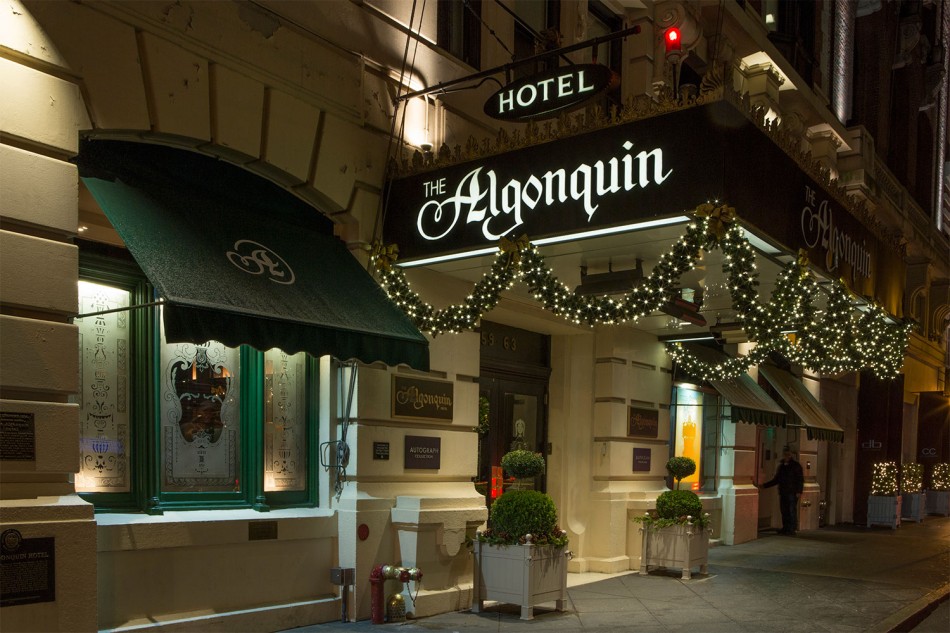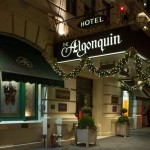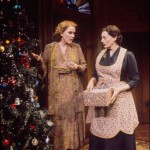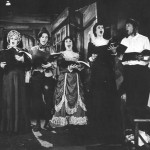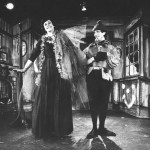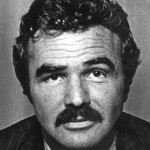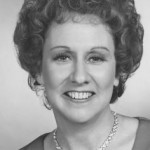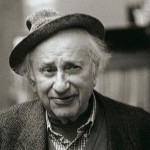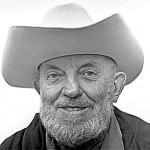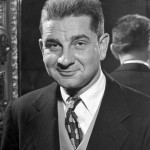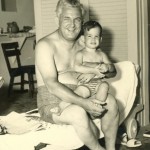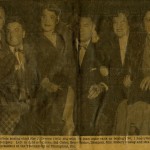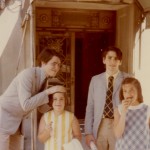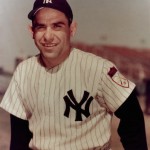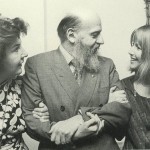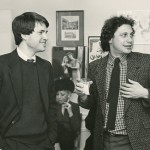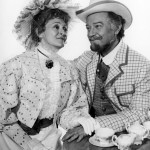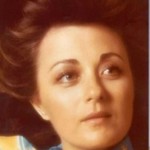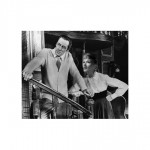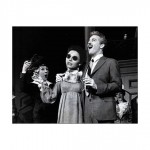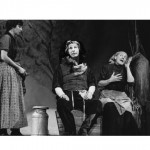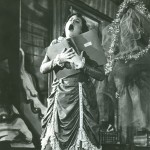by Michael Elihu Colby
Part 17: You Mean, That Arnold Schwarzenegger?
(click on all photos to enlarge)
Returning home for the holidays was a special treat now that home happened to be the Algonquin. I’d fly in after a morning of finals at Northwestern University and arrive at a lobby filled with glittery wreathes, mistletoe, and a glamorous, golden Christmas tree. The Algonquin had several holiday traditions. For one, on Christmas Eve, all Algonquin guests received red-mesh stockings hung late on their doors, filled with tangerines, candy canes, chestnuts, and other goodies. Then there was the hotel’s festive New Year’s Eve. Celebrants would pack the Rose Room and lobby for dinner, furnished with every sort of noisemaker and flamboyant hat. Then, as midnight sounded on the lobby’s stately grandfather clock, the spotlight turned to Charley, the Chinese busboy, who’d worked at the hotel for decades. Looking like a skinny Father Time, he strutted up and down the aisles, beating a gong and becoming the beaming Algonquin star of the moment.
Amid all the Yuletide cheer, my grandparents were Jews who would, to some extent, celebrate both Chanukah and Christmas. But celebrating Christmas was quite common for Southern Jews of a certain generation. This is a phenomenon I discussed in detail when I once worked with Alfred Uhry, the Jewish writer from Georgia, whose plays, Driving Miss Daisy and Last Night of Ballyhoo, portray such Jewish Christmasmania. Growing up in the Five Towns, I had both a traditional menorah and a not-so-traditional tree. The tree was justified—and kosherized—with hanging Jewish stars, a plastic bulb I created depicting “Santa Claus’ bar mitzvah” (his red hat served as a yarmulke), and more bulbs containing “Broadway” figurines designed by me: Joel Grey, Angela Lansbury, and Maria Karnilova (from Fiddler On the Roof and Zorbá!). My father—who’d never celebrated Christmas—wasn’t thrilled about this. But my brothers and I were elated to get gifts on both holidays. And I always enjoyed being creative with that tree. At night, when everyone else was asleep, I would lie under the colorfully lit tree and observe the rainbow of reflections on our ceiling in the quiet of the night. Then, on Christmas Eve—with holiday movies on TV and no one in the house fighting—I truly felt the peace on earth.
My knowledge of Christmas would come in handy in 1979. The occasion was right after an off-off Broadway group, the Lyric Theater of New York, presented a reading of Another Time, my first collaboration with composer Gerald Jay Markoe. The well received show was a musical version of Jean Anouilh’s Time Remembered featuring Maria Karnilova and Carolyn Mignini (Tintypes). Happy with our work, the company’s artistic director, Neal Newman, asked if Gerry and I had a show they could do as a staged reading at Christmas time. We didn’t. But that didn’t stop me from saying, “You got it!” Then this nice Jewish boy spent the perfect amount of time—twelve days—writing the first draft of a Christmas musical mixing every holiday cliché I could imagine. The result was Ludlow Ladd, an all-sung, all-rhymed operetta about an orphan boy, born on Christmas Eve, searching for a loving home. It was staged by Raymond Benson (now a best-selling novelist) as one ongoing Christmas carol, where the performers held their scripts like carolers, thereby not needing to memorize. Ludlow Ladd was well liked and received several subsequent productions. We were very lucky with this show, especially when we cast a soprano with an incredibly high voice, Mara Beckerman. Mara would become a continuing inspiration to me (Incidentally, the same role was later played by another ingénue with an incredibly high voice, Kristin Chenoweth).
I look back now and realize that Ludlow Ladd was a subconscious reflection of my childhood: it included squabbling parents and a holiday night assuaged by a beautiful Christmas tree—when the tree metamorphoses into a magical guardian named Missus Pinecones. Ludlow Ladd was so much fun for everyone that Gerry and I wrote a sequel, expressly for Mara’s high voice. The sequel, Charlotte Sweet, was pretty lucky too. It received Drama Desk Award nominations for Gerry, Mara, and me. Once more, holidays were central to the plot. In it, Ludlow Ladd, the character born on Christmas Eve, is betrothed to Charlotte, a high soprano born on St. Valentine’s Day, culminating in a joyful New Year’s scene. Even though many of my future musicals would contain Jewish themes, non-Jewish holidays and settings have figured prominently. But, then again, I’m just following a long tradition when you consider the Jewish songwriters of such standards as “White Christmas” (Irving Berlin), “We Need a Little Christmas” (Jerry Herman), “Santa Baby” (Joan Javits & Phil Springer), “Rudolph, the Red-Nosed Reindeer” (Johnny Marks), “Sleigh Ride” (Mitchell Parish) and “Easter Parade” (Irving Berlin).
Even after the holiday season, the Algonquin was a festive place to be as my Winter break continued. Stepping into the elevator, I’d be elbow to elbow with such current stars as Burt Reynolds, Jean Stapleton, Patty Duke, and Ellen Burstyn. In addition, there would be impressive celebrities whose faces weren’t so recognizable, such as Oscar-winning filmmaker Costa-Gavras (Missing, Z), writer Studs Terkel, photographer Ansel Adams, and cartoonist Charles Addams (who was surprisingly genial and straight-laced in person, nothing like you’d expect of the creator of The Addams Family). In 1973, however, the hotel housed a bunch of especially atypical guests. Charles Gaines wrote about these visitors in Men’s Journal. One was an Austrian—then a 4-time winner of the bodybuilding competition, Mr. Olympia—who would go on to become a famed actor and governor of California:
We had arranged for Arnold and a group of other bodybuilders to stay while they were in New York at that bastion of the delicately sensible life, the Algonquin Hotel, in whose small, exquisite lobby they were studied like metaphors in some obscure language. On this September morning, a literary agent and I turned the corner onto West 44th Street off Sixth Avenue, and there was Arnold, walking like a wave breaking toward the hotel from the other end of the block, followed by a retinue of bodybuilders and their vivid girlfriends. He was wearing emerald green shorts. His centaur legs were a bright copper color from a new coat of Tan-in-a-Minute. A car full of his buddies turned onto 44th and slowed beside him, and suddenly the whole street was alive with bodybuilders, driving up in cars, coming out of the hotel. The doorman and the taxi drivers gaped: These huge, outrageous people seemed conjured from the sparkling air. There was laughter from one of the cars and a shout as it pulled off. Out in the street Arnold whooped mightily and kicked at the departing fender. There were maybe two dozen pairs of eyes in front of the Algonquin, and all of them watched his ornately carved leg wink outward in a high, floating punt that seemed to catch the New York morning smack in the bustle. 1
It was the same writer, Charles Gaines, who launched Schwarzenegger’s acting career. Gaines fought strong opposition to cast Schwarzenegger as a lead in the movie version of Gaines’ novel about bodybuilders, Stay Hungry. Yet, even without any acting experience, Schwarzenegger was a natural as muscle-man “Joe Santos.” He won a Golden Globe as “Best New Actor” and became a movie icon.2 Still, there’s no denying, without this stroke of good fortune, Schwarzenegger probably would have lacked the muscle to make it in movies or politics.
I only wish, being away at college, I hadn’t missed the spectacle of Arnold Schwarzenegger at the Algonquin. Still, Schwarzenegger wasn’t as incongruous with the hotel as one might think at first. After all, its then owner, Ben B. Bodne, had a background in competitive athletics. Back in 1946, my grandfather purchased the hotel as a fallback position when he lost out in the bidding for the Pittsburgh Pirates. But Grandpa never gave up on sports. For a while, he juggled his Algonquin responsibilities with being co-founder (in 1948) of the Tournament of Champions—a P.R. outfit that promoted boxing figures like Marcel Cerdan, Jack Dempsey, and Rocky Graziano.3 The outfit was eventually sold to the Madison Square Garden group.
Throughout his life, Grandpa’s avocation was sports, both as an aficionado of all athletic events, and as an avid golfer. He used to say he’d bring along two pairs of trousers when he played golf, “In case I get a hole in one.” But baseball was his favorite. My cousin Roxanna Anspach Devlin recalls the fantastic times she experienced accompanying him when he had season tickets to the New York Yankees. His seats were right behind the dugout. He’d schmooze with the players on their breaks. If that wasn’t exciting enough for his pre-teen granddaughter, Grandpa introduced Roxanna to Reggie Jackson, pitcher Ron Guidry, catcher Thurman Munson, and shortstop Mickey Rivers. One day, when Roxanna thought she was going to meet the cartoon character Yogi Bear, Grandpa instead presented her to Yogi Berra. He also taught her everything one needs to know about baseball—to love it—and she did.
Grandpa took me to some exciting Yankee games too, but it was evident I knew more about the musicals, Damn Yankees and I Had a Ball, than I did baseball. Still, I could instruct Grandpa on who the guests were at the Algonquin, when he didn’t know. He probably had no idea who George Spelvin was, even though the Algonquin was the monthly setting for “Friends of George Spelvin” lunches for Playbill Magazine. Theatre buffs know that George Spelvin is the name customarily given as a red herring for a role that either doesn’t really appear or is covered by an actor in a unrecognizable disguise.4 The “Spelvin” lunches were held in the Stratford Suite, hosted by Leo Lerman, the influential editor of Conde Nast Magazine. These gala lunches began in November, 1970 and continued for the next 20 years. At these luncheons, Lerman invited casts and creators of current shows to mingle with Playbill advertisers.5 Among the shows feted were: A Little Night Music; Pippin; No , No, Nanette; Follies; The Sunshine Boys; and Equus. That meant, around lunchtime during my vacations, I could literally take bets on “how many Tony nominees you could squeeze” into the tiny Algonquin elevator. But the theatricality didn’t stop there. Besides the regular guests, there were staff members who had high cultural aspirations, as described in a New York Magazine article:
Many front-desk clerks worked in the arts—one showed his photographs at O.K. Harris gallery, another wrote plays (featuring the guests), a third was an actor who had a walk-on part in the movie Reversal of Fortune and roles in several plays. The bartenders included a painter, a poet affiliated with the St. Mark’s Poetry Project, and a few writers.6
Gordon Edelstein, who was once a waiter at the hotel (and who hails from the Five Towns), is now the artistic director of the Long Wharf Theatre and an acclaimed Broadway director. Tony Speciale, who clerked behind the front desk, was artistic director of the Classic Stage Company and recently directed Barry Manilow‘s musical, Harmony. The place has always been a magnet for artistic types—you should never take for granted the person serving you there.
In 1973, I was able to observe the return to the hotel of Alan Jay Lerner and Frederick Loewe. This time, they were working on their stage version of the movie classic Gigi. The stage version had its problems. But—even with inevitable comparisons to the movie version—the Broadway cast was topnotch. It included Alfred Drake, Agnes Moorehead, and my personal favorite, Maria Karnilova. Yet there was a hole in the center: a so-so “Gigi” where an enchanting ingénue was required. The actress originally cast during the tryout had been replaced by the understudy, but not sufficiently. The show could have used the magic I witnessed when the recasting of a vital role in Applause helped transform that musical into a hit. Moreover, I happened to know that, during its tryout, Gigi had a different understudy for the title role, a terrific one. Her name was Udana Power and she was a protégée of Alan Jay Lerner. I’d met her when she stayed at the Algonquin on another project. I was not surprised to hear that she had been Lerner’s personal choice to play the part. Winsome and adorable, she would have made an ideal “Gigi.” But, during the tryout of Gigi, Udana dropped out as understudy for what she considered a stronger prospect, playing “Melanie Wilkes” (the Olivia de Havilland role) in a musical version of Gone With the Wind. I later had the occasion to see Udana as “Melanie,” and she was captivating, receiving excellent reviews—even though the show itself was panned. Ultimately, Gone With the Wind deflated, never making it to New York. But there might have been a happier ending for Gigi, had Udana stayed with the Lerner & Loewe show. As it was, she did appear successfully in some TV sitcoms like Soap.
The situation reminded me of how success in the Arts is often predicated on a series of flukes. There are countless musicals that might have turned out very differently with actors who were seriously considered for leads but—for a variety of reasons—not cast. Imagine a parallel universe with the first-approached Mary Martin (not Julie Andrews) in My Fair Lady, Danny Kaye (not Robert Preston) in The Music Man, Eydie Gormé as “Polish Rose” in Bye Bye Birdie (rather than Chita Rivera as “Spanish Rose”), Anne Bancroft (not Barbra Streisand) in Funny Girl, Nell Carter (not Jennifer Holliday) in Dreamgirls, and Danny Kaye again in Fiddler On the Roof (not Zero Mostel). *mock ups created by Michael Colby
As far back as I can remember, I’ve been astonished by the vagaries of this profession. There have been so many actors I thought should be stars who never got that break. There have been shows that opened to just the right critic in The New York Times, when other critics disliked the show (Inversely, there have been shows that were audience hits until some critics—perhaps in a cranky mood—got to them). The examples are endless. One stroke of good or bad luck can be crucial in show business. Just look at how Arnold Schwarzenegger got started. Look at how fortunate I was that my grandfather bought the Algonquin instead of the Pittsburgh Pirates. Later in my life, serendipity was a major contributor to my own musicals: like the Christmas tree central to Ludlow Ladd; or the random audition of a high-voiced soprano that inspired Charlotte Sweet. Even my collaboration with the composer of Charlotte Sweet was based on a fluke: being introduced because Gerry Markoe, searching for a lyricist, phoned the first agent listed in the phone book, Charles Abramson.
In my future, there would be a multitude of flukes and what-if’s. Fortunately, I’d be grateful for how it all averaged out.
Next part: Fast Forward
1 Gaines, Charles. “The Arnold Schwarzenegger I Knew” in Men’s Journal, New York NY: Wenner Media. January 2004: http://www.mensjournal.com/magazine/the-arnold-schwarzenegger-i-knew-20130727Wenner media.
2 Gaines, Charles. Ibid.
3 Grody, Ray. “Just a Minute” in Milwaukee Sentinal, August 8, 1948.
4 Editor. “George Spelvin” in Encyclopaedia Britannica © 2014: www.britannica.com/EBchecked/topic/559232/George-Spelvin.
5 Lerman, Leo. The Grand Surprise: The Journals of Leo Lerman. New York NY: Random House LLC. February 19, 2009.
6 Grinstead, David. “Ghosts” in New York Magazine. New York, NY: October 19, 1992.
© 2014, Michael Colby
*No copyright Infringement Intended. For Entertainment Purposes Only.
Click Below for Parts 1 thru 16 :
https://www.theaterpizzazz.com/algonquin-kid-part-way-back/
https://www.theaterpizzazz.com/algonquin-kid-part-2-algonquin-renaissance/
https://www.theaterpizzazz.com/algonquin-kid-part-3-series/
https://www.theaterpizzazz.com/algonquin-kid-part-4-series/
https://www.theaterpizzazz.com/algonquin-kid-part-5-series/
https://www.theaterpizzazz.com/algonquin-kid-part-6-series/
https://www.theaterpizzazz.com/algonquin-kid-part-7-mazel-tov-robert-f-kennedy/
https://www.theaterpizzazz.com/algonquin-kid-continues-part-8-series/
https://www.theaterpizzazz.com/algonquin-kid-part-9-british-staying/
https://www.theaterpizzazz.com/algonquin-kid-musicals-r-us-part-10/
https://www.theaterpizzazz.com/algonquin-kid-learning-ropes-part-11/
https://www.theaterpizzazz.com/algonquin-kid-doesnt-happen-holiday-inn-part-12/
https://www.theaterpizzazz.com/algonquin-kid-part-13-series/
https://www.theaterpizzazz.com/algonquin-kid-moving-days-part-14/
https://www.theaterpizzazz.com/algonquin-kid-part-15-excelsior/
https://www.theaterpizzazz.com/algonquin-kid-coming-attractions-part-16/


